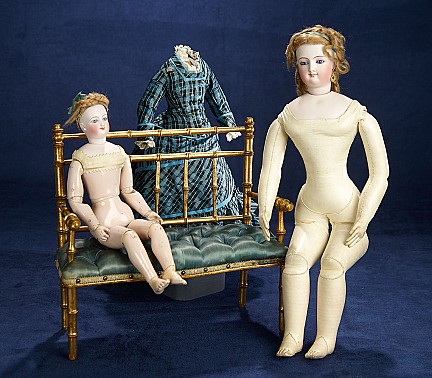Extremely Rare German Bisque Art Character, Model 103, by Kammer and Reinhardt
Lot #10
23" (58 cm.) Bisque socket head with deeply sculpted characterized features of solemn-faced older child, deeply-set eye sockets with heavy eye lids, painted blue/grey eyes, black upper eyeliner, grey eyeshadow at lower rims, accented nostrils, closed mouth, shaded lips, blonde mohair wig, composition and wooden ball-jointed body, antique costume. Condition: generally excellent, some typical wig pulls at back of head. Marks: 103. Comments: Kammer and Reinhardt, from their art character series, circa 1910, the model was created in one size only, 58 cm. Value Points: Among the rarest models from the German art character period, with exceptional quality of modeling, appealing almost as though hand-pressed sculpting, and with most artistic complexion and painting of features, original body and body finish, original wig. Only one other example of the 103 model has been sold by Theriault's, from the Legoland Museum of Antique Dolls and Toys. Historical Note: Although it has long been known that the model (and its companions, the 104 and 105 models) were made by Kammer and Reinhardt, the actual back story of the dolls remained a mystery until 1987, nearly 80 years after their creation, thanks to the tireless research of German scholars, Marianne and Jurgen Cieslik. The first clue appeared in memoirs of Franz Reinhardt who said that in the firm's quest to create a new type of realistic doll "we contacted a Berlin artist who had been recommended to us". But no mention was made of the artist's name. Then, years later, another clue surfaced, it was an obscure reference in a German newspaper article of 1928 which dealt with the Walterhausen doll industry which said "the first dolls of this type were created based on the head of a baby modeled from nature by Professor Lewin-Funcke". Based on this obscure clue, the Ciesliks tracked down the family of Lewin-Funcke and uncovered still more important information regarding which models that famed Berlin sculptor had created and who had served as the model. They learned that the model for the 103, 104, and 105 models was Karin Lewin-Funcke, the daughter of the sculptor. An old handwritten note from K*R described the 103 model as "girl/serious", made in the 58 cm. size only.
























































































































































































































































































































































